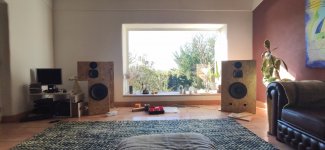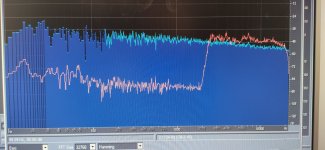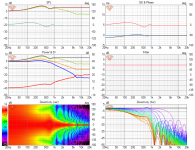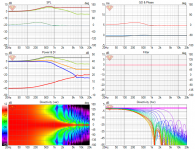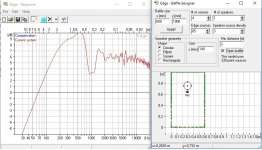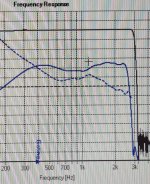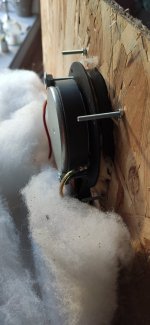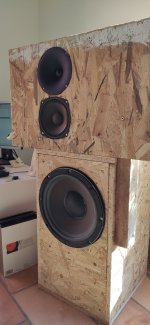I guess with a mid in open baffle including waveguided tweeter, one should find optimal width depending on cutoffs...
What would you recommend for a mid playing 300-2000hz?
I guess I have to looke closely at Nelson pass and linkwith open baffle design.
I read troels article his 80cm OB seems to perform well...
Apparently softening the surface with cork or absorbant material is good too.
What would you recommend for a mid playing 300-2000hz?
I guess I have to looke closely at Nelson pass and linkwith open baffle design.
I read troels article his 80cm OB seems to perform well...
Apparently softening the surface with cork or absorbant material is good too.
^ I haven't done open baffles but I read they are used below the diffraction, where they act like dipole, below the "dipole peak", with long enough wavelengths before the driver frame starts to introduce diffraction. For this reason perhaps a 5" driver would be fine for below 2000Hz duty. If you stretch it all the way down to 300Hz the max SPL capability of the system might be limited. Open baffle driver will roll out 6dB per octave below the "dipole peak" so it is > 10db down at 300Hz. You could use bigger driver, and/ or wider baffle to augment the lows more in exchange of the top of the bandwidth performance, diffraction, in order to reach lower with some required SPL. All about compromises 🙂 For this reason open baffle speakers are three or more way.
As with Troels, I don't know his speakers and methodology. Although, if you search over his site with diffraction there is not many mentions. And he doesn't do (or at least show) off axis measurements which would reveal diffraction quite easily. My interpretation is old school designer selling kits to make money. Which doesn't mean they don't sound good, only that they are no good metric for diffraction performance, if that matters. They would sound even better without diffraction, if Geddes study isn't fake which I doubt.
As with Troels, I don't know his speakers and methodology. Although, if you search over his site with diffraction there is not many mentions. And he doesn't do (or at least show) off axis measurements which would reveal diffraction quite easily. My interpretation is old school designer selling kits to make money. Which doesn't mean they don't sound good, only that they are no good metric for diffraction performance, if that matters. They would sound even better without diffraction, if Geddes study isn't fake which I doubt.
If someone tries to learn the full picture by listening to others tell the story, but without learning it for themselves, so they can tell the full picture it becomes incorrect (like Chinese whispers/telephone game)it is worth it to point them details out if you spot one so the full picture gets more focus
narrow baffle will allow more energy to travel back, reflect off the wall behind the speaker and then recombine with the forward wave with a delay causing response irregularities just the same as baffle edge diffraction does ...Can you pin point what is wrong so I and others can comment on it? Many posts I forget to write some important detail out which can make edge cases. I mostly talk with relative terms, since many things affect, and it is worth it to point them details out if you spot one so the full picture gets more focus. so please come forward with your thoughts 🙂 Otherwise my post is pretty solid since it is all about wavelength, physical property of sound and how it interacts with physical objects, and not my opinion or how I wrote it out.
Luckily forum format allows back and forth discussion so that many point of views, broad and narrow focus, all kinds of things get spelled out. Hopefully so that a reader and participants can have their own thought process and learning over it.
so all narrow baffle does is reduce your system's output causing you to turn the volume up which increases distortion ...
EDIT: forgot to mention - the real solution to edge diffraction is to use waveguides that direct the sound forward so that less energy reaches the edge of the cabinet and therefore diffracts ... all professional speakers are designed this way.
Last edited:
^ I haven't done open baffles but I read they are used below the diffraction, where they act like dipole, below the "dipole peak", with long enough wavelengths before the driver frame starts to introduce diffraction. For this reason perhaps a 5" driver would be fine for below 2000Hz duty. If you stretch it all the way down to 300Hz the max SPL capability of the system might be limited. Open baffle driver will roll out 6dB per octave below the "dipole peak" so it is > 10db down at 300Hz. You could use bigger driver, and/ or wider baffle to augment the lows more in exchange of the top of the bandwidth performance, diffraction, in order to reach lower with some required SPL. All about compromises 🙂 For this reason open baffle speakers are three or more way.
As with Troels, I don't know his speakers and methodology. Although, if you search over his site with diffraction there is not many mentions. And he doesn't do (or at least show) off axis measurements which would reveal diffraction quite easily. My interpretation is old school designer selling kits to make money. Which doesn't mean they don't sound good, only that they are no good metric for diffraction performance, if that matters. They would sound even better without diffraction, if Geddes study isn't fake which I doubt.
For example what I am experimenting :
60cms width, 80cms high baffle, low section included ported. Tweeter badly integrated no waveguide not even flush mount. I can measure 2 bumps in the highs.
Mid speaker works and measures fine until crossover rolloff at 300hs...
Listening impression are very good and basic measures don't show any catastrophe... Not sure my ears could ear those higher bumps corrected...I am waiting for waveguided 30mm wavecor tweeter...
Maybe 50-60cms is good compromise for the mid section.
As said read some documents about surface treatment as efficient or more as shape...
Some things to look at..
Includes tweeter measure at 80cm
Attachments
Last edited:
what you can try is build a box but only make the baffle out of wood. make the left, right, top and bottom sides out of thick foam ( like from an old mattress ), and leave the back side of the box completely open.For example what I am experimenting :
60cms width, 80cms high baffle, low section included ported. Tweeter badly integrated no waveguide not even flush mount. I can measure 2 bumps in the highs.
Mid speaker works and measures fine until crossover rolloff at 300hs...
Listening impression are very good and basic measures don't show any catastrophe... Not sure my ears could ear those higher bumps corrected...I am waiting for waveguided 30mm wavecor tweeter...
Maybe 50-60cms is good compromise for the mid section.
As said read some documents about surface treatment as efficient or more as shape...
Some things to look at
i think it would be an interesting experiment.
this would give you a few more variables you can control to influence the overall response of your open baffle speaker.
You could teach me please, I'm all about learning. All you do is hint my posts are wrong over and over again, which isn't helpful at all without explanation, only confusing.If someone tries to learn the full picture by listening to others tell the story, but without learning it for themselves, then when they tell the full picture it becomes incorrect (like Chinese whispers/telephone game)
Nice, never thought it out that way. Also, as AllenB has commented earlier on my posts on diffraction on some other thread that the thinking is wrong because wall sized baffle (in-wall speakers) wouldn't diffract. And there he is correct, the edge case, there is limit where diffraction is a concern. All stuff around the listening space diffract and reflect for sure. The baffle width is compromise taken by the designer, if wide baffle is of benefit for the system you should go for it. Just don't ignore the diffraction as it is found to be highly audible type of distortion by mr. Geddes.narrow baffle will allow more energy to travel back, reflect off the wall behind the speaker and then recombine with the forward wave with a delay causing response irregularities just the same as baffle edge diffraction does ...
so all narrow baffle does is reduce your system's output causing you to turn the volume up which increases distortion ...
For narrow baffle more energy radiating backside of the speaker is true. This could be addressed with acoustic treatment on the room in addition to what I already mentioned like open baffle or cardioid box. Although, low frequencies require lots of treatment there might be point of diminishing return. For example ~15" wide baffle already reduces output to back ~10dB around ~800Hz a 32" wide baffle takes this down to around 250Hz. Reducing 250Hz 10dB with acoustic treatment would take thick layer of it. Downside is the diffraction now at ~700Hz, but crossover below this and there is no problem with it. Attached is ideal 15" driver on ideal 15" baffle and 32" baffle (VituixCAD diffraction sim) and while these do not represent the full reality in 3D, it is enough to illustrate the point between wide and narrow baffle in terms of diffraction effects. The wide baffle diffraction in this example causes interference which shows as on axis dip and off-axis peak around 700Hz. Box depth for example, would effect in which direction the least amount of energy is pointed at (and which frequency). In the examples this is around 135degrees, which could be exactly the direction of specular reflection on front wall for toed in speaker. This would make the ~-10db frequency down to ~400Hz for minimal baffle, and (almost) no diffraction problems.
My intention is not to fight about it, just to illustrate wide baffles are not problem/diffraction free and narrow baffles aren't just for looks. Ignoring diffraction in general is silly, for any project. If diffraction is accepted as compromise it is fine, every speaker is full of compromises and the system as whole needs to be considered, toe-ins and all included.
Attachments
Last edited:
the goal is to send as much energy forward as possible and at the same time to randomize as much as possible the energy that could not be sent forwardYou could teach me please, I'm all about learning. All you do is hint my posts are wrong over and over again, which isn't helpful at all without explanation, only confusing.
Nice, never thought it out that way. Also, as AllenB has commented earlier on my posts on diffraction on some other thread that the thinking is wrong because wall sized baffle (in-wall speakers) wouldn't diffract. And there he is correct, the edge case, there is limit where diffraction is a concern. All stuff around the listening space diffract and reflect for sure. The baffle width is compromise taken by the designer, if wide baffle is of benefit for the system you should go for it. Just don't ignore the diffraction as it is found to be highly audible type of distortion by mr. Geddes.
For narrow baffle more energy radiating backside of the speaker is true. This could be addressed with acoustic treatment on the room in addition to what I already mentioned like open baffle or cardioid box. Although, low frequencies require lots of treatment there might be point of diminishing return. For example ~15" wide baffle already reduces output to back ~10dB around ~800Hz a 32" wide baffle takes this down to around 250Hz. Reducing 250Hz 10dB with acoustic treatment would take thick layer of it. Downside is the diffraction now at ~700Hz, but crossover below this and there is no problem with it. Attached is ideal 15" driver on ideal 15" baffle and 32" baffle (VituixCAD diffraction sim) and while these do not represent the full reality in 3D, it is enough to illustrate the point between wide and narrow baffle in terms of diffraction effects. The wide baffle diffraction in this example causes interference which shows as on axis dip and off-axis peak around 700Hz. Box depth for example, would effect in which direction the least amount of energy is pointed at. In the examples this is around 135degrees, which could be exactly the direction of specular reflection on front wall for toed in speaker. This would make the ~-10db frequency down to ~400Hz for minimal baffle, and (almost) no diffraction problems.
My intention is not to fight about it, just to illustrate wide baffles are not problem/diffraction free and ignoring diffraction in general is silly, for any project. If diffraction is accepted as compromise it is fine, every speaker is full of compromises.
the reason wider baffles have more pronounced diffraction effects isn't because wide baffle is bad, but because when you move the baffle step down in frequency you are now in a range where a speaker is less directional and paints the edges of the baffle with more energy
however the wider baffle actually allows you additional room for a waveguide to control speaker directivity such that it does NOT send all that energy to the edge but forward
ultimately you're trying to send energy forward but it's trying to go back because it wants to take the path of least resistance which is to go spread itself evenly
a waveguide is your first line of defense for preventing the energy from going back
the baffle is your second line of defense
once it broke through both those barriers now you can put some acoustical treatment on the wall to absorb reflections
or you can randomize shapes of various boundaries ( both baffle edge and wall ) to scramble all these reflections ...
just keep in mind that all speakers designed for consumers put style above all other considerations - they design speakers to look sexy first and then they argue that this somehow results in better sound
the fact that narrow low diffraction style baffles are more prevalent in consumer than professional speakers should tell you that it has more to do with style than substance ...
You are correct, the problem is not the sound source being wide, but the empty flat baffle around it, which supports the frequencies below the source beaming to interact with the edge. For sure, waveguides would be best, controlled directivity, although they too have mouth reflection without proper termination which shows discrepancy between on-/off-axis sound so waveguides aren't problem free either, although they can be (see ATH thread on the multiway forum). This is part of the "modern speaker design" where the off-axis sound is cared about, reflections should sound similar as direct sound.the goal is to send as much energy forward as possible and at the same time to randomize as much as possible the energy that could not be sent forward
the reason wider baffles have more pronounced diffraction effects isn't because wide baffle is bad, but because when you move the baffle step down in frequency you are now in a range where a speaker is less directional and paints the edges of the baffle with more energy
however the wider baffle actually allows you additional room for a waveguide to control speaker directivity such that it does NOT send all that energy to the edge but forward
How far one should go with the various compromises, like width of baffle, depends on the application. For most home audio applications I don't see much problem with getting enough SPL before distortion regarding baffle size, because the distortion starts from the very lows, not because small baffle but because insufficient cone area. Although even at pro audio applications I don't see wide baffle much, perhaps on the oldies goldies in-wall studio monitors, but other pro applications (both live sound, studio work) seem to be minimal baffle (or in-wall) or with generous roundovers. PA sound just utilizes multiple boxes, line arrays, million subs, high value in utility. On the consumer sector the narrow baffle is very convenient since it is easy to manufacture (just a box), looks nice, and has low diffraction. There are some wide baffle speakers on hi-end audio though, but most of them have generous roundovers as well. Debating which sound better is not my point, there are many things in system besides baffle width that determine system sound. I could bet though, that less diffraction sounds better than more, while everything else stayed the same.
This is the problem I see, which makes me post, is that people don't seem to remember to think downsides, the trade-offs. Going for SPL capability that is never utilized with trade-off in diffraction performance just seems poor design choice to me. Yeah you can off course have the SPL capability and perhaps you need it in your application, just ignoring/downplaying/not thinking about the diffraction is silly, is my point. I admit I have no idea where the diminishing returns are, and for which sized room. 15" on minimal baffle gets quite much attenuation to the back pretty low in frequency already, much smaller 8" cardioid or open baffle could get even more attenuation lower in frequency, towards specular reflection point, all without much diffraction before crossing over to a waveguide. Although less SPL capability. Always a compromise, optimize for application.
There are plenty of ways looking at things and many things to optimize in any speaker system. Trying to help, remind about diffraction.
Last edited:
Hi, nice! Experimenting is mucho fun!🙂 although, the measurement seems in-room measurement including reflections in the room and the peaks and dips would pretty much average out. Also, the SPL scale on the graph is quite much, there is about ~12db difference on peak and dip around 4kHz for example.For example what I am experimenting :
60cms width, 80cms high baffle, low section included ported. Tweeter badly integrated no waveguide not even flush mount. I can measure 2 bumps in the highs.
Mid speaker works and measures fine until crossover rolloff at 300hs...
Listening impression are very good and basic measures don't show any catastrophe... Not sure my ears could ear those higher bumps corrected...I am waiting for waveguided 30mm wavecor tweeter...
Maybe 50-60cms is good compromise for the mid section.
As said read some documents about surface treatment as efficient or more as shape...
Some things to look at..
Includes tweeter measure at 80cm
Many things audio are not so obvious, most speakers sound just fine, enough for ear to detect the song, lyrics and get emotional about the song if it is personally relevant. While the hifi hobby is very much fun it can often be quite small difference that make or break it. A reference pair would help ***** "absolute quality" in a way, provide something to beat with our own designs. Beat it and it is golden, no matter if there was little ripple in response here or there. Have fun!🙂
Yes I have to find a different way of measuring, maybe holmimpulse of arta...
I will also try doing an openbox with some foam as side panels...
When I have my wavecor tweeter it will be better to compare sound and measurements...
I can think of several reasons why wide baffle are not so popular. One reason given for neo magnet is size and weight... efficiency, max SPL, integration....
But I'd like to understand what I could do and how. What is sure is that this kind of wide range medium pleases me for home use...
Edit : I like to compare with headphones in the end, kind of reference point
I will also try doing an openbox with some foam as side panels...
When I have my wavecor tweeter it will be better to compare sound and measurements...
I can think of several reasons why wide baffle are not so popular. One reason given for neo magnet is size and weight... efficiency, max SPL, integration....
But I'd like to understand what I could do and how. What is sure is that this kind of wide range medium pleases me for home use...
Edit : I like to compare with headphones in the end, kind of reference point
Ah I have now realized we talk a bit differently on this as I doubted from the get go 😀the fact that narrow low diffraction style baffles are more prevalent in consumer than professional speakers should tell you that it has more to do with style than substance ...
By narrow I mean the baffle is not wider than the transducer and wide in my view would be baffle that is wider than the transducer(s). You are correct, home speakers are narrow and pro speakers are wide in absolute measure (for example 6" or 15"), but most of both home and pro speakers are narrow in sense they are not much wider than the transducers on it. It is all relative, 15" driver on 15" baffle will diffract as little as 6" driver on a 6" baffle. Extending baffle step to lower frequency by widening the baffle, without widening the source on it, will introduce "more diffraction" as the bandwidth between baffle step and driver beaming gets wider. Illustrated in the VCAD examples earlier, as well as in your comment "the reason wider baffles have more pronounced diffraction effects isn't because wide baffle is bad, but because when you move the baffle step down in frequency you are now in a range where a speaker is less directional and paints the edges of the baffle with more energy".
Last edited:
I have been playing with HolmImpulse and first thing I can Say is that it is not easy to measure speakers particulary at home...
Anyway it seems that I am measuring diffraction even from the mid driver...
Simulation from Edge / Basta software
It is also difficult to choose between different kind of filters : high slope, lower slope... Not talking about phases now, I just put some 0.14ms delay between low and mid (300hz, 12inc vs 6.5inch)
Anyway it seems that I am measuring diffraction even from the mid driver...
Simulation from Edge / Basta software
It is also difficult to choose between different kind of filters : high slope, lower slope... Not talking about phases now, I just put some 0.14ms delay between low and mid (300hz, 12inc vs 6.5inch)
Attachments
Yeah it is bit of a task, especially with larger speakers. Checkout VituixCAD documentation for example, has instructions how to get best measurement results in livingroom. Link to measuremen document top of this page: https://kimmosaunisto.net/
Thanks,
I think I will print all these pdf at work to read them. It's driving me nuts on the phone...
I have to install arta Also, I think I will buy an rme soundcard so I can upgrade everything on win 10...
I think I will print all these pdf at work to read them. It's driving me nuts on the phone...
I have to install arta Also, I think I will buy an rme soundcard so I can upgrade everything on win 10...
I made some work, installed monacor waveguide, which is not made for the Audax tw34, made new baffle with help of edge software (shifted speakers on the side basically) trying to see if would change the results...rounded the edges a little bit with the router and flushed the speakers...
Made some more measures, it is true that it was better...
Looking forward to trying wavecor waveguided tweeter... Perhaps I will also try an equivalent medium to compare...
Made some more measures, it is true that it was better...
Looking forward to trying wavecor waveguided tweeter... Perhaps I will also try an equivalent medium to compare...
Attachments
Cool! try it without baffle, or perhaps just enough baffle/structure to support the drivers upright 🙂
Is there any other method than the c-c increase, to smooth out the vertical response? The increased c-c distance is ugly to my eyes. 😀3. c-c is increased to ~25cm and the vertical interference is "bettered" to make very smooth transition, almost no hump at all around xo frequency on the transition between the woofer and waveguide. These graphs include effects of both horizontal and vertical off-axis response, horizontal didn't change much with c-c so the "improvement" is due to "better" vertical off-axis response.
Yes it is a bit odd looks 🙂 If you make a freestanding waveguide the c-c distance is easy to manipulate and not too bad visually. You could raise the crossover frequency as well if you wanted, change the wavelenght, try if it makes a difference.
Many things change doing it with xo frequency though, like horizontal pattern would change a bit at least for example. But if you hear difference, for better or for worse, you'd be happy you tried and were able to choose the better one. Or if you didn't hear difference what so ever, you'd have gained valuable experience still because some aspects of loudspeakers are more important than others. Perhaps this is something that is very important, or not important at all unless trying to get the very last drop of audio quality al else already optimal for the application.
For many systems longish c-c could make sense though, quite reasonable thing try and optimize sound of first reflections if there is possibility without bad trade-offs, for free, especially if it makes easier build. I've taken the stuff more like a stress relief than anything, "permits" thinking systems bit differently, like a relatively big freestanding waveguide possibly far enough from relatively small woofer structure so that both have reduced fingerprint on the other acoustically, getting out from each other way. More separation of concern, if it mattered 😀 Anyway, a bit more extra design freedom opposed to trying to squeeze stuff as close as possible, which might come handy for some systems at least.
Many things change doing it with xo frequency though, like horizontal pattern would change a bit at least for example. But if you hear difference, for better or for worse, you'd be happy you tried and were able to choose the better one. Or if you didn't hear difference what so ever, you'd have gained valuable experience still because some aspects of loudspeakers are more important than others. Perhaps this is something that is very important, or not important at all unless trying to get the very last drop of audio quality al else already optimal for the application.
For many systems longish c-c could make sense though, quite reasonable thing try and optimize sound of first reflections if there is possibility without bad trade-offs, for free, especially if it makes easier build. I've taken the stuff more like a stress relief than anything, "permits" thinking systems bit differently, like a relatively big freestanding waveguide possibly far enough from relatively small woofer structure so that both have reduced fingerprint on the other acoustically, getting out from each other way. More separation of concern, if it mattered 😀 Anyway, a bit more extra design freedom opposed to trying to squeeze stuff as close as possible, which might come handy for some systems at least.
Last edited:
- Home
- Loudspeakers
- Multi-Way
- Faital & 18 Sound 3 way
